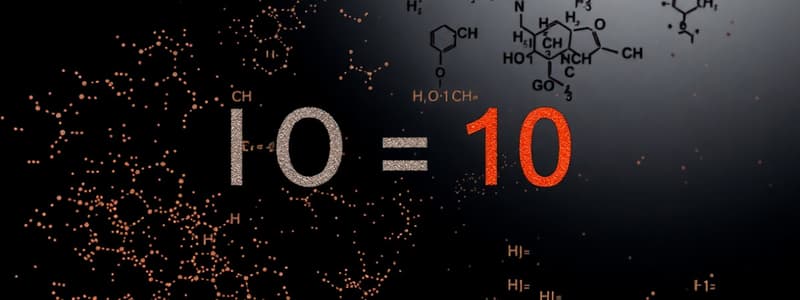Podcast
Questions and Answers
What occurs during the oxidation of magnesium?
What occurs during the oxidation of magnesium?
- It loses neutrons.
- It gains protons.
- It gains electrons.
- It loses electrons. (correct)
A reducing agent is always oxidized during a chemical reaction.
A reducing agent is always oxidized during a chemical reaction.
True (A)
What is the term used for a substance that brings about oxidation in other substances?
What is the term used for a substance that brings about oxidation in other substances?
oxidising agent
During redox reactions, oxidation is associated with the ______ of electrons.
During redox reactions, oxidation is associated with the ______ of electrons.
Match the following elements with their roles in a redox reaction:
Match the following elements with their roles in a redox reaction:
What does the acronym OILRIG stand for?
What does the acronym OILRIG stand for?
In a redox reaction, oxidation and reduction can occur independently of each other.
In a redox reaction, oxidation and reduction can occur independently of each other.
Each sodium atom loses one electron and each chlorine atom gains one electron in the formation of ______.
Each sodium atom loses one electron and each chlorine atom gains one electron in the formation of ______.
What is the oxidation number of sulfur in Na2S2O3?
What is the oxidation number of sulfur in Na2S2O3?
The oxidation number of nitrogen in the NO3^- ion is -5.
The oxidation number of nitrogen in the NO3^- ion is -5.
What rule does oxygen generally follow regarding its oxidation number?
What rule does oxygen generally follow regarding its oxidation number?
In oxidized species, the oxidation number (______/decreases).
In oxidized species, the oxidation number (______/decreases).
What is the general oxidation state of hydrogen in its compounds?
What is the general oxidation state of hydrogen in its compounds?
The sum of oxidation numbers in a compound must equal the total charge of that compound if it is a complex ion.
The sum of oxidation numbers in a compound must equal the total charge of that compound if it is a complex ion.
What oxidation number is assigned to halogens in compounds with more electronegative atoms?
What oxidation number is assigned to halogens in compounds with more electronegative atoms?
Which substance acts as the reducing agent in the given reaction?
Which substance acts as the reducing agent in the given reaction?
Match each element to its typical oxidation number:
Match each element to its typical oxidation number:
Chlorine displaces bromine from a bromide salt solution.
Chlorine displaces bromine from a bromide salt solution.
What color does the potassium iodide solution turn when chlorine water is added?
What color does the potassium iodide solution turn when chlorine water is added?
In the reaction between sodium sulfite and chlorine water, _____ ion is present when barium chloride is added.
In the reaction between sodium sulfite and chlorine water, _____ ion is present when barium chloride is added.
Match the following elements with their role:
Match the following elements with their role:
What is the oxidation state of sulfur in sulfuric acid?
What is the oxidation state of sulfur in sulfuric acid?
The reaction produces I2 when potassium iodide is mixed with bromine water.
The reaction produces I2 when potassium iodide is mixed with bromine water.
What color does the potassium bromide solution turn when chlorine is added?
What color does the potassium bromide solution turn when chlorine is added?
What is the product of the oxidation of iron(II) ions in the presence of chlorine?
What is the product of the oxidation of iron(II) ions in the presence of chlorine?
A greenish-brown precipitate indicates the presence of Fe^2+ ions.
A greenish-brown precipitate indicates the presence of Fe^2+ ions.
What color does the copper sulfate solution become when magnesium is added?
What color does the copper sulfate solution become when magnesium is added?
When Zn displaces Cu^2+, the resulting metal coating on zinc is ______.
When Zn displaces Cu^2+, the resulting metal coating on zinc is ______.
Match the following reactions to their outcomes:
Match the following reactions to their outcomes:
What half-reaction represents the oxidation of iron(II) ions?
What half-reaction represents the oxidation of iron(II) ions?
What is the oxidation number change of aluminum in the reaction 8Al + 3Fe3O4 → 4Al2O3 + 9Fe?
What is the oxidation number change of aluminum in the reaction 8Al + 3Fe3O4 → 4Al2O3 + 9Fe?
In the reaction Cd + H^+ + NO3^-- → Cd^2+ + NO + H2O, Cd acts as the oxidizing agent.
In the reaction Cd + H^+ + NO3^-- → Cd^2+ + NO + H2O, Cd acts as the oxidizing agent.
Zinc has a lower tendency to lose electrons than copper.
Zinc has a lower tendency to lose electrons than copper.
What is the reducing agent in the reaction 8Al + 3Fe3O4 → 4Al2O3 + 9Fe?
What is the reducing agent in the reaction 8Al + 3Fe3O4 → 4Al2O3 + 9Fe?
The balanced half-equation for the reduction of permanganate ions shows that MnO4^- requires ______ electrons to become Mn^2+.
The balanced half-equation for the reduction of permanganate ions shows that MnO4^- requires ______ electrons to become Mn^2+.
In the equation Mn O4^- + 5Fe^2+ + 8H^+ → Mn^2+ + 5Fe^3+ + ______, the product formed is water.
In the equation Mn O4^- + 5Fe^2+ + 8H^+ → Mn^2+ + 5Fe^3+ + ______, the product formed is water.
Match the following species with their roles in the given reactions:
Match the following species with their roles in the given reactions:
Flashcards
Oxidation
Oxidation
Loss of electrons by an element
Reduction
Reduction
Gain of electrons by an element
Redox Reaction
Redox Reaction
A reaction where oxidation and reduction occur simultaneously.
Oxidising agent
Oxidising agent
Signup and view all the flashcards
Reducing agent
Reducing agent
Signup and view all the flashcards
Oxidation number
Oxidation number
Signup and view all the flashcards
Example of redox reaction
Example of redox reaction
Signup and view all the flashcards
Chlorine's role in water treatment
Chlorine's role in water treatment
Signup and view all the flashcards
Oxidation Number of an Element
Oxidation Number of an Element
Signup and view all the flashcards
Oxidation Number of Oxygen (General)
Oxidation Number of Oxygen (General)
Signup and view all the flashcards
Oxidation Number of Hydrogen (General)
Oxidation Number of Hydrogen (General)
Signup and view all the flashcards
Oxidation Number Rules in Compounds
Oxidation Number Rules in Compounds
Signup and view all the flashcards
Oxidation Number of Halogens
Oxidation Number of Halogens
Signup and view all the flashcards
Calculating Oxidation Numbers
Calculating Oxidation Numbers
Signup and view all the flashcards
Halogens' Oxidizing Ability
Halogens' Oxidizing Ability
Signup and view all the flashcards
Chlorine's Oxidizing Power
Chlorine's Oxidizing Power
Signup and view all the flashcards
Sulfate Formation
Sulfate Formation
Signup and view all the flashcards
Halogen Displacement
Halogen Displacement
Signup and view all the flashcards
Oxidation of Iron(II) sulfate
Oxidation of Iron(II) sulfate
Signup and view all the flashcards
Reduction of Chlorine
Reduction of Chlorine
Signup and view all the flashcards
Displacement Reaction (Zinc)
Displacement Reaction (Zinc)
Signup and view all the flashcards
Displacement Reaction (Magnesium)
Displacement Reaction (Magnesium)
Signup and view all the flashcards
Balancing Redox Equations
Balancing Redox Equations
Signup and view all the flashcards
Half-reaction (Oxidation)
Half-reaction (Oxidation)
Signup and view all the flashcards
Half-reaction (Reduction)
Half-reaction (Reduction)
Signup and view all the flashcards
Balancing Redox Reactions
Balancing Redox Reactions
Signup and view all the flashcards
Redox Reaction (Example)
Redox Reaction (Example)
Signup and view all the flashcards
Study Notes
Oxidation and Reduction
- Oxidation: Loss of electrons
- Reduction: Gain of electrons
- OILRIG: Oxidation is Loss, Reduction is Gain
- Redox reactions: Oxidation and reduction always occur together
- Oxidising agent: Substance that brings about oxidation in other substances.
- Reducing agent: Substance that brings about reduction in other substances.
Oxidation Numbers
- Oxidation number: Charge that an atom has or appears to have when electrons are distributed according to rules.
- Oxidation numbers are used for tracking electrons in chemical reactions, especially in covalent compounds.
- Rules for assigning oxidation numbers:
- Uncombined element = 0
- Ion of an element = charge of the ion
- Oxygen = -2 (except in peroxides and OF2)
- Hydrogen = +1 (except in metal hydrides)
- Halogens = -1 (except when bonded to a more electronegative atom)
- Sum of oxidation numbers in a neutral compound = 0
- Sum of oxidation numbers in a polyatomic ion = charge of the ion
Oxidation and Reduction in Terms of Oxidation Numbers
- Oxidation: Increase in oxidation number
- Reduction: Decrease in oxidation number
- Oxidising agent: The substance that is reduced.
- Reducing agent: The substance that is oxidized.
Studying That Suits You
Use AI to generate personalized quizzes and flashcards to suit your learning preferences.




